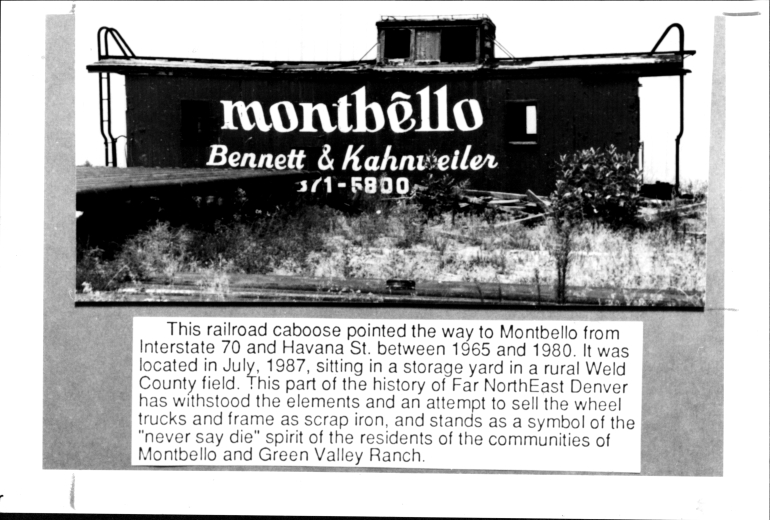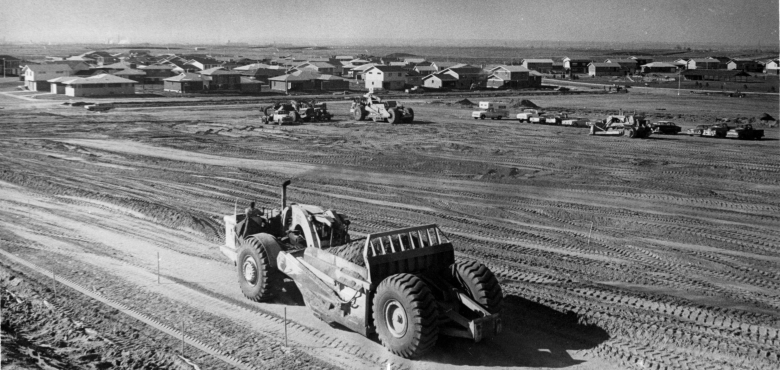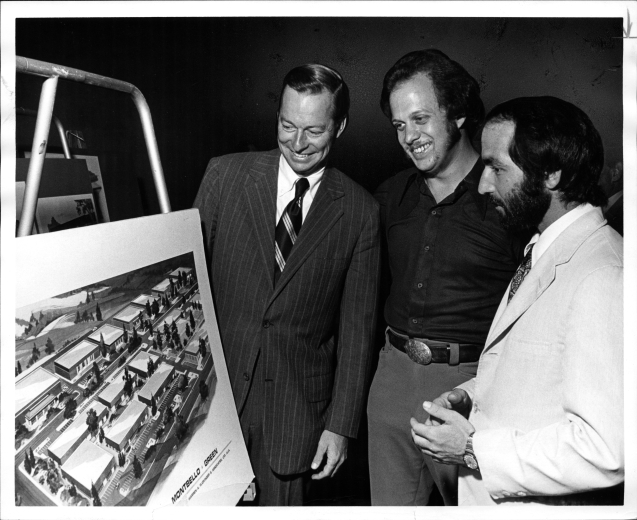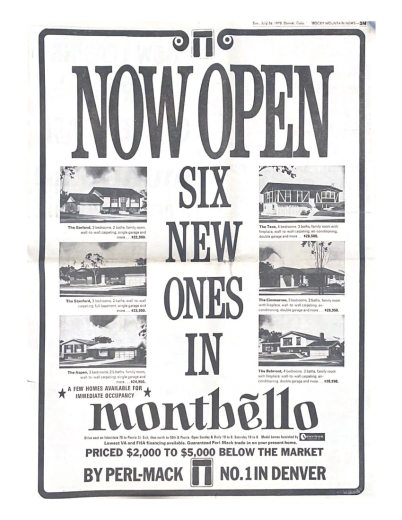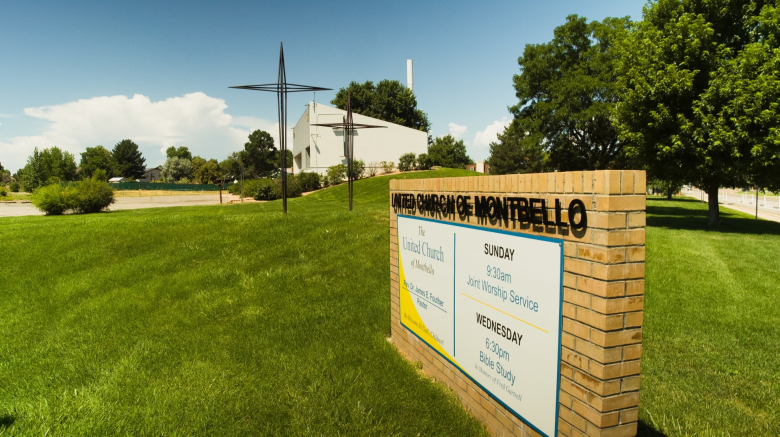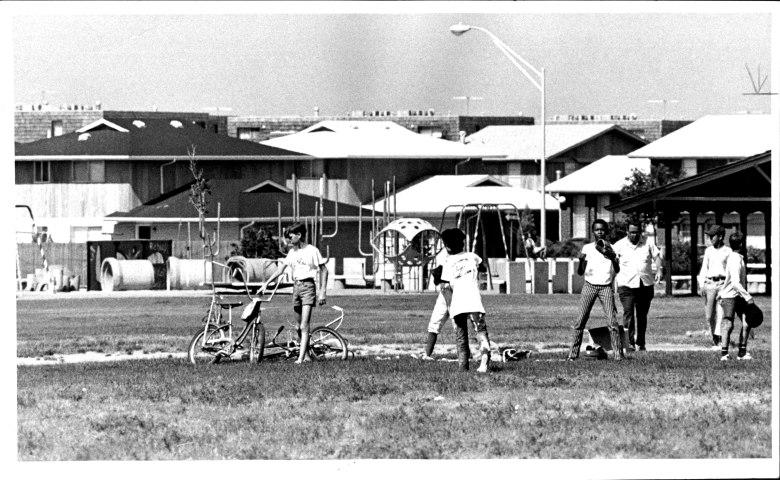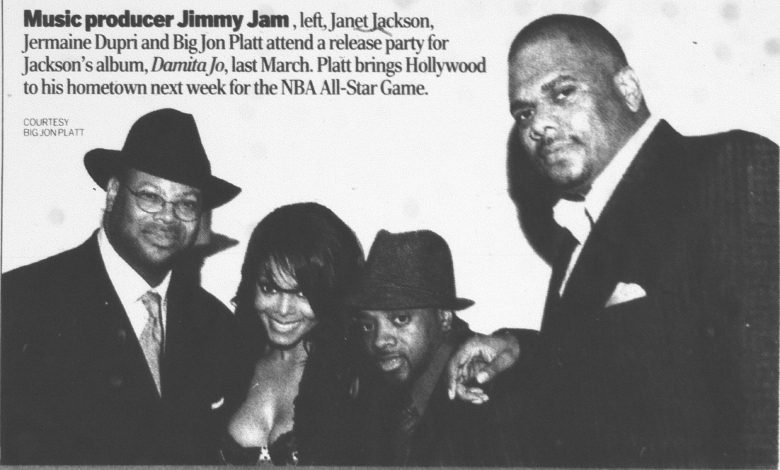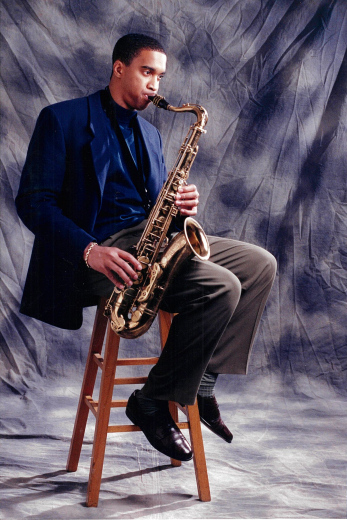In the northeast corner of Denver sits the “city within a city:” Montbello. The Montbello neighborhood is young. Going back just 60 years, the land that is now home to thousands of families and hundreds of businesses was inhabited by cattle and cowboys. While this neighborhood is fledging, it is not without character. Montbello’s history tells the story of a vibrant community who continually embraces diversity and stands united, undeterred by adversity.
Before Montbello was established, the land that the neighborhood sits on was owned by the Kansas Pacific Railway Company and was virtually untouched. In the 1880s, an agricultural visionary named Cyrus G. Richardson purchased 6,000 acres of land in the North East Denver area from Kansas Pacific. According to a 1909 promotional pamphlet, Richardson saw untapped potential in Denver and had a vision to create an “agricultural Eden” out of his new land. However, Richardson passed away abruptly, halting the development. Richarson’s land was passed on to his wife, Julia (Tibbals) Richardson, and managed by his cousin, Albert H Packard. In 1911, Julia Richardson consolidated her holdings into a single farm – which encompassed all of present-day Montbello – that cultivated wheat, alfalfa, mules, and cattle. After Julia’s death, the farm was passed on to the sole inheritor, Packard, who later died without an inheritor in 1934.
Packard’s death ushered in a new era of regional dominance. Patriarch Joseph “Joe” Miller was a Jewish immigrant from Wilma, Lithuania, who arrived in the United States in 1877. Miller moved around the US and eventually settled in Denver, opening a meat market with his brother, Sam, around the turn of the century. Miller gradually began expanding his enterprises to include cattle ranching and brought in five of his sons to begin his firm Miller and Co. In 1934, the firm purchased the entire Monbello Area for $4.00 an acre, which became home to Miller’s 2,500 cattle as well as the local wildlife like deer, coyotes, foxes, prairie dogs, and rattlesnakes.
In the mid-twentieth-century, the city of Denver began expanding rapidly eastward. Construction began on the US Arsenal (now the Rocky Mountain Arsenal) in 1942, the Old Stapleton airport opened in 1944, and Denver purchased a lot on Smith Road and Havana Street to begin construction on a new county jail in 1953. In 1963, the Miller ranch stopped all grazing as a result of the impending construction of Interstate 20, which was open for use the following year. The grandson of Joe Miller, Myron “Mickey” Miller, saw this expansion as an investment opportunity for his family’s land.
The younger Miller partnered with Sam Primack of the Pearl-Mack Enterprises – a Colorado-based housing development company – to introduce the idea of the Montbello neighborhood. On June 30th, 1965, the city and county of Denver acquired the largest land annexation in the city’s history: the entire 2,932-acre Miller ranch was annexed from Adams County into Denver County. Micky Miller stayed with the project to oversee the use of his family land as an attorney for the Montbello developers. Montbello was the deal that kicked off the young Miller’s career and helped him expand his family business. Subsequently, Micky Miller’s business grew into Miller Global Properties – a massive real-estate development corporation that played a formative role in developing Denver in the second half of the 20th century – where he currently sits as co-chairman.
The sale of the miller ranch jump-started the formation of the hyper-planned Montbello community. The project was spearheaded by a development triumvirate made of Perl Mack (which oversaw residential development), Bennet and Kahnweiler (a Chicago company that organized the Industrial Park), and Urban Investment Development Co. (another Chicago development company in charge of the commercial affairs). These developers worked together to fashion a ‘city within a city’ with 1770 acres dedicated to residential land, 800 acres designated to commerce and industry, and the remaining acreage allotted for community areas like churches, parks, and schools. In 1966, the first single-family home went up for sale, with prices ranging from $14,950-$21,950. The affordability of these first homes enticed a proud and diverse bunch of homebuyers. According to the 1970 census, of the 4,976 people living in Montbello, 314 were Black, and 396 were Hispanic.
The community was conceptualized following the suburban fads sweeping the United States in the 1960s; the roads were softly curved, yards and greenspaces were prioritized, and the houses were ranch-style and ready-made once selected out of the Pearl-Mack Catalog. In the development stage, Montbello was described by the Rocky Mountain News as “the first complete, balanced, and pre-planned community to be built in the Rocky Mountain area." Not only did developers manufacture the community, but they also manufactured the name. It is rumored that the name Montbello came from one of two places. First, it was presumed that the neighborhood was named after the city of Montbello in California. The other theory is that it is named for the views of Mount Evans and Longs Peak, as Monte Bello in Italian means beautiful mountain. However, neither theory is correct. During the initial development, an associate from the Western History department spoke with a Pearl Mack employee, and he reported that “the name was made up by the developer. It is not named for Montbello in California” and “the current spelling does not translate as ‘beautiful mountain’ since it is missing the letter e to make the Italian phrase correct.”
Montbello’s location at the northeast extreme of the city, sandwiched between I-70 and the Rocky Mountain Arsenal National Wildlife Refuge, gave the area a feeling of containment and isolation from the rest of Denver. The distinctly suburban feel, the enclosed industry, and the distance of the development from the city center earned the neighborhood its popular denomination of “a city within a city.” While the suburban containment was enjoyed, the isolation from Denver made it easier for the city to ignore the needs of the neighborhood, like building schools and improving infrastructure.
The Industrial Park of Montbello was just as intentional as the residential spaces. The Park was completely sold out in five years with over 100 sales transactions, with notable tenants including JC Penny and the headquarters of the Samsonite corporation. By 1966, it was estimated that the park created 8,000 jobs in the community and brought in $1.5 million a year in real estate taxes. It was evident by this time that the community of Montbello was not just self-sustaining but immensely profitable for the city at large. It was expected that some of these profits would go towards developing community services in Montbello – schools most importantly. However, for generations, Montbelloans have had to fight tooth and nail for services their industrial success should have paid for.
In the 1990s, it was the Montbello Industrial Park that drew investors to the city. At the beginning of the decade, 22 buildings in the park sold for a total of $25 million, marking one of the largest local real estate purchases at that time and, according to the Denver Post, this transaction “[changed] the national perception of the Denver economy.” Despite Samsonite choosing to move its headquarters out of Denver in 2006, the Montbello industrial park still makes up an essential part of the Denver economy. As of 2017, 1,276 businesses were operating in Montbello.
In 1980, almost 15 years after the establishment of Montbello, the neighborhood opened its first secondary education school: Montbello Junior Senior High School. Prior to the school’s opening, community members had been pleading for a high school in the neighborhood. The previous lack of this institution took a toll on the community. Students were bused all across the city to fulfill diversity requirements in accordance with the desegregation effort, leaving the community almost completely devoid of its youth population. A local school meant children did not have to spend hours on a bus, parents did not have to worry about their children in a neighborhood across the city, and community members could hire high school students for part-time work. Students could play for sports teams in their community, and residents had an institution to rally behind. The community could finally come together.
When the school opened, the busing effort was put to an end because the community was naturally integrated. Educators remarked on the success of the interracial relationships built between students at Montbello compared to the artificially integrated schools, where it was rare for white students to mingle with students of color outside the classroom. This success is largely attributed to students’ ability to see their friends outside the classroom and around their own community.
Almost since the school opened, there had been issues of overcrowding and academic underachievement – the two often go hand in hand. Students and faculty worked hard to better the institution's reputation, but prejudice and underfunding were rampant, and in 2014, the school shut down due to low graduation rates and test scores. Without MHS, the student body was split into smaller schools, and the community was once again splintered. In typical Montbello fashion, residents fought hard and long, and the school reopened in 2022. The feeling around the reopening is reminiscent of that in 1980, with one community member saying, “The school is…the heart of Montbello.”
Parkfield Lake Park is an 82-acre park located in the northeast corner of Montbello. The park is home to many recreational and community services, including sports fields and courts, picnic areas, an amphitheater, playgrounds, a dog park, a skate park, a 1-mile trail, and the Montbello Rec Center. With all these amenities and ample green space, the park has made itself a hearth for the community.
One example of the park’s importance to the community is Montbello Alive! which is an annual event held in Parkfield Lake Park. Hosted by the Montbello Organizing Committee, Montbello Alive! recognizes the “vibrant, diverse, and resilient neighborhood and its residents.” The celebration acknowledges the anxieties facing the Montbello community – including a lack of access to healthy foods, infrastructure development, high-achieving schools, and affordable housing. More importantly, Montbello Alive! seeks to highlight Montbello’s ability to join together to overcome. Community-led organizations like the Montbello Organizing Committee, Struggle of Love Foundation, Montbello 2020, and Families Against Violent Acts are all celebrated during the event for their success in uplifting and bettering the neighborhood from within.
Beyond its significance to the community, the park's landscaping and design further exemplify its commitment to sustainability. In an effort to promote sustainability, the 2011 remodel of the park limited the amount of irrigated turf and instead used artificial turf wherever necessary. The natural plants and grasses within the park are watered using recycled water from a stormwater system. The remodel also reintroduced plants and grasses that are native to the Colorado plains.
One of the most important amenities in the park is the Montbello Rec Center. Montbello residents lobbied for 15 years to replace the exceptionally overcrowded rec center – another testament to the community's internal passion. The present facility opened in 2003, offering residents an acceptable place to recreate. The facility offers a myriad of different means of exercise, but takes a keen focus on youth services, offering free youth membership as well as a free meal program for local kids.
An emblem of Montbello's diversity and tolerance is the longstanding United Church of Montbello. Established in 1968, the parish was founded by the United Methodist, United Presbyterian, United Church of Christ, and Reformed Church in America. The ecumenical parish has always been a place to build tolerance and understanding between the Christian faiths. In 1970, Reverend G. Kent Keller described a typical service saying,
“We used a Methodist hymnal pulpit and a cross from a congregational church (now the United Church of Christ), the order of worship from the Reformed Church and I, a Presbyterian minister, was in charge.”
Not only is UCM a haven of religious tolerance, but ethnic tolerance as well. Despite being founded during a racially turbulent time in the United States, the parish was integrated from the get-go, with a 20% Black congregation in the 1960s. Since then, the United Church of Montbello has remained a diverse, welcoming parish and is a beacon for community outreach and organizing. In 2019, the church was recognized by the Colorado Sun for its Urban Farm initiative. The UCM urban farm works with around 500 local youths to produce over 10,000 pounds of food for the community every crop cycle. For over 50 years, the United Church of Montbello has been emblematic of the larger communities values of tolerance, unity, and altruism.
The neighborhood unjustly holds monikers like “Montghetto” and Denver’s “stepchild” not because of a lack of care and involvement from Montbello community members, but rather a history of neglect and ignorance from its parent city. Since the community’s inception, residents have felt ignored by the city and have been forced to work and plead for basic community services like grocery stores, public transportation, schools, and recreation services. This continued neglect is a driving cause of Montbello's “image problem,” the inaccurate and prejudiced perception of the community. This negative characterization is reinforced by the continuous dismissal and negative media coverage of Montbello and its residents. Archival research on the neighborhood presents a sensationalized view of the neighborhood: ripe with crime and local challenges. However, the minimal amount of dialogue included in press accounts from community members gives a more accurate portrayal: a community that is underserved by its dominant municipality with a set of dedicated residents working to showcase their greatness and overcome their neglect.
This disenfranchisement is even more upsetting considering the ethnic and racial makeup of the neighborhood and how it became that way. Montbello was conceived as an affordable housing community. Due to this accessibility, Montbello was naturally established as an ethnically and economically diverse community while much of the US – particularly in suburban areas like Montbello – was exceptionally segregated. Early on the neighborhood was majority white with substantial Black and Hispanic minorities. Throughout the 1970s the Black population rapidly increased- ‘racial steering’ was a crucial factor contributing to this increase.
In 1959, Colorado was the first state in the United States to codify a law against housing discrimination. Nine years later, the fair housing act was passed federally. Despite these laws, discrimination in real estate persisted in Denver, and Montbello is no exception. Over 20 years after the implementation of the Colorado Fair Housing Law, Denver realtors were charged with racial steering in Montbello. According to James Reynolds, the executive director of the Colorado Civil Rights Commission, realtors were “steering black people to Montbello and implying to white people that they [did not] want to go there.” This unsettling practice is clear evidence of both housing discrimination and institutionalized racism seeing that the deliberately majority black community struggled to receive funding and services from the city.
Decades later, Montbello continues to grapple with significant challenges. In 2020, Montbello had 36,000 residents and only one grocery store – a Walmart located at the eastern edge of the neighborhood. This created a deficit in healthy and accessible food options for Montbello residents, making the neighborhood a food desert. Community members once again banded together to advocate for their community's needs. In 2020, the Montbello Organizing Committee (MOC) acquired the land for their FreshLo Hub, a multi-use economic development project aimed to
“promote cultural heritage, rejuvenate physical spaces, improve health outcomes, and bring diverse people together. Upon completion, FreshLo will provide affordable housing, a cultural center, office space for businesses and nonprofits, and – most urgently – a grocery store.”
The MOC broke ground on the project in March of 2023 and hopes to open the grocery store later that year, providing affordable and healthy food options that the community desperately needs.
Montbello stands as a testament to the power of continuous community action and perseverance in the face of neglect and adversity. Throughout its history, this neighborhood has remained a shining example of diversity, transitioning from majority white to majority African American and currently being a majority Latino community. Despite these demographic shifts and differences among its residents, one common thread unites them all – their unwavering dedication to improving their community. In the face of continuous oversights and disparities, Montbelloans have banded together to provide for their neighborhood, working tirelessly to secure essential services, address food insecurity, and create economic opportunities.
Montbello native, Jon Platt, is the Current CEO of Sony Music Publishing. Before his time at Sony, Platt served as the president of Warner Chapple for three years and was a hip-hop pioneer at EMI for seventeen years. Platt is credited as a central catalyst for hip-hop’s rise to mainstream at the turn of the century. Jay-Z aptly summarized Platt's impact calling him the “Obama of the music industry.”
Jon Platt was born in Philadelphia in 1964, but considers his hometown to be Denver. Having lived in multiple neighborhoods in the city, around the age of 10, Platt began establishing roots in Montbello when his family moved to a home on East 51st Avenue and Quentin Street. Coming from a single-parent home, Platt’s mother worked security at Rocky Flats to support her family. Platt attended Montbello Junior-Senior High School from 1980-82. He began his career in music when a coworker at the Dave Cook sporting goods store in Aurora got him into DJing. He first started spinning records at the former Norman's Place club in Aurora. During his first set there, Platt said only six people showed up; luckily, four of them were local high school basketball stars from Manual and George Washington who were taken with Platt and helped him grow his Denver audience. Quickly, Platt established himself as a force in the Denver club scene; Chauncey Billups, a Nuggets legend and longtime friend of Platt, told the Denver Post, “If you had Big Jon there, that was the place to be.” A conversation with the Public Enemy frontman Chuck D inspired Platt to move to Los Angeles and pursue his larger career goals.
Upon arrival in LA, Platt immediately began making waves on the management side of the music industry when he landed the production of a remix of the 2Pac single "Keep Ya Head Up." Shortly after “Keep Ya Head Up,” he earned his promotion to Vice president at EMI for acquiring the production rights to TLCs Mega hit “Don’t Go Chasing Waterfalls.” Platt credits his success in the music industry to his ability to “take care of business” while maintaining his love for music. His logic is as follows:
“I sign because I'm a fan of theirs first. And that makes it easy for me to help them because I already know what fans want to hear.”
This formula proved to yield amazing results during Platt's time at EMI; he signed a myriad of legendary acts such as Beyonce, Jay-Z, Drake, Rihanna, Kanye, and Pharell Williams.
A cornerstone of Platt’s executive style is his relationship with his artists. Sean “P Ditty” Combs told the Denver Post that Platt “has an amazing ear and sense of knowledge because publishing isn’t just a business, it’s an art” and “he has a gift, a natural talent for it. He knows how to build relationships. He’s built relationships with me and a lot of the guys who are the future of music.” These relationships that go beyond business allow Platt to make cunning business decisions that benefit himself and his artists. Jay-Z credits Jon Platt for the success of the 2010 hit single “Empire State of Mind” because Platt connected Jay and Alicia Keys on the project. Additionally, Platt pioneered the current music business system that forces producers to foot the bill, instead of artists, when they choose to sample another song on a record – codifying Platt’s artist-forward business philosophy.
Platt’s ability to honor the creative prowess of his acts while simultaneously amplifying their marketability promoted him to CEO of Warner/ Chappell Music in 2015. In 2018, Platt moved to CEO of Sony Music Publishing. At both companies, he has prioritized diversity, equity, and inclusion, hoping to “represent what the industry really is” and foster an industry side of music that matches the diversity of both the talent and the listeners.
Despite leaving Denver and achieving great success, Platt remains connected to his Montbello roots. In 2005, a particularly difficult year for Montbello High School students after a fatal stabbing occurred on campus, Platt felt the need to support the community that supported him. So, Platt attended and funded his Alma Mater’s prom. Additionally, that year, Platt began awarding his annual Big Jon Platt Scholarship, which goes to three Montbello seniors. The scholarship highlights student success in three categories: overcoming adversity, academic excellence, and an interest in a career in the music industry.
Joy-Ann (Lomena) Reid was born in 1968 in Brooklyn, New York, to immigrant parents; her mother was from Guyana, and her father was from the Democratic Republic of the Congo. When Reid was two, the Lomena family left Brooklyn for Denver, where they settled in Montbello. The Lomenas first lived on Sable Street, where Reid attended Ford Elementary, and after a move to 17th Avenue Circle, she transferred to McGlone. Reid and her two siblings were primarily raised by her mother (her father returned to the DRC when Reid was a young girl) who was a college professor and nutritionist. In 1986, Reid graduated from Montbello Junior-Senior High School and went off to Harvard, where she pursued her studies in film. Tragically, her mother died of breast cancer that same year.
Reid remembers her transition from Montbello to Harvard as a considerable adjustment; going from a norm of diversity and middle class to the mecca of East Coast elites was a challenge. Reid credits her admission to Harvard to affirmative action and strongly condemns the 2023 supreme court decision to end affirmative action. Saying that because of affirmative action, “someone came to Denver, Colorado to look for me… a very qualified person, who they would have never known existed otherwise.” In 1991, Reid graduated from Harvard with a concentration in documentary film.
In the late 90s, Reid moved to Miami, where she began her career in TV writing for a local morning show. She quickly established herself among her peers in South Florida as a political activist for minority groups. In 2011, Reid was appointed editor of the MSNBC website The Grio, a news source aimed at Black readers. During this time, Reid was also writing Op-eds for the Miami Harold and gaining recognition for her opinions and debate skills. In 2015, Reid made her return to New York as a national correspondent for MSNBC, where she hosted her own shows, including “The Reid Report” and “AM Joy.” Reid is also a New York Times bestseller with her books, The Man Who Sold America: Trump and the Unraveling of the American Story and Fracture: Barack Obama, the Clintons, and the Racial Divide.
Although he was born in Carthage, Missouri, in 1965, Javon Anthony Jackson was raised in Denver. He grew up in a musical family with a pianist mother and a trumpeter father. He was among the first generation of kids to be raised in Montbello and was a part of the third graduating class from Montbello Junior-Senior High School. After graduating, Jackson briefly attended the University of Denver and then went on to attend the prestigious Berklee College of Music in Boston. Jackson left Berklee in 1986 to join the jazz combo “The Jazz Messengers,” led by the revered Art Blakey. It was with Blakey that Jackson made an exciting return to his home bandstand of El Chapacultec in 1988. Jackson remained with the Jazz Messengers until Blakey’s death in 1990. In 1991, Jackson made his recording debut with “Me and Mr. Jones,” featuring James Williams, Christian McBride, and master drummer Elvin Jones. Jackson went on to join Jones’ group the following year, making appearances on the “Youngblood” and “Going Home” albums. In 1994, Jackson was signed to the Blue Note label, where he crafted four recordings throughout the 1990s that featured a wide range of acts, including Frank Zappa, Santana, Muddy Waters, and Al Green, as well as many other notable musicians.
In 2009, Jackson composed the score for the Alfred Hitchcock film “The Lodger.” Commissioned by the Syracuse film festival, the full-length score accompanied the silent film and was performed live by Jackson’s band in 2010. In 2022, under his own label, Solid Jackson Records, Jackson released his acclaimed album “The Gospel According to Nikki Giovanni.” The album is a jazz interpretation of a collection of gospel hymns and spirituals. It was nominated for an NAACP Image Award in 2023 for Outstanding Instrumental Jazz Album and was featured by the Kennedy Center.
Apart from being a renowned composer and musician, Jackson is also an educator. After finishing his degree at Berklee, Jackson received his master's and taught at the State University of New York at Purchase. For the past ten years, Jackson has directed the Jackie Mclean Institute of Jazz Studies at the Hartt School of Music, Theatre, and Dance at the University of Hartford.
Outside DPL Sources
- In Montbello, A Future of Promise and Challenge
- Montbello High School welcomes first incoming students since 2014
- Montbello Organizing Committee
- AY-Z PAYS TRIBUTE AS JON PLATT COLLECTS SPIRIT OF LIFE AWARD
- Montbello grad’s gift positive spin
- Big Jon Platt: Music-Biz Powerhouse and Jay-Z Pal on His Montbello Roots
- Jon Platt on diversity, equity and inclusion: ‘It’s not lip service’
- Joy: Conservative justices welcome affirmative action—of legacy students
- How Joy Reid of MSNBC Became a Heroine of the Resistance
- Javon Jackson
- Growing community: How Colorado religious leaders are farming food — and a new variety of faithful
DPL sources
- Celebrating Montbello's 30th anniversary
- The Denver school book : the history of Denver Public Schools. Volume One: 1859-1967 / by Phil Goodstein
- Clippings DENVER. NEIGHBORHOODS. MONTBELLO (Available Upon Request)

